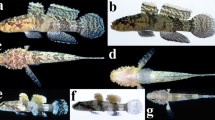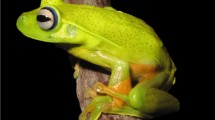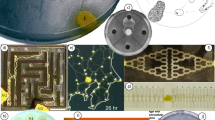Abstract
Silver nitrate staining of the solenidial and eupathidial sensilla on the palpi, tarsi and tibiae of legs I and II of Arrenurus acutus, Geayia ovata, Mideopsis reelfootensis and Albia caerulea, along with ultrastructural studies, showed that these setae have a porous shaft cuticle. These setae are hollow and contain dendrites in their lumens and more than one neuron is associated with each setae. Behavioural experiments supported the involvement of these sensilla in the perception of chemical cues from prey and sexual partners.
Similar content being viewed by others
References
Altner, H. and Prillinger, L. 1980. Ultrastructure of invertebrate chemo-, thermo-, and hygroreceptors and its functional significance. Int. Rev. Cytol. 67: 69–139.
Atema, J., Fay, R.R., Popper, A.N. and Tavolga, W.N. 1987. Sensory Biology of Aquatic Animals. Springer-Verlag, New York.
Baker, G.T. 1985. Morphology of the solenidia and famulus on tarsi I and II of Rhizoglyphus robini Claparede (Acaridae). Zool. Jb. Anat. 113: 85–89.
Böottger, L. 1970. Die Ernührungsweise der Wassermilben (Hydrachnellae, Acari). Int. Rev. Ges. Hydrobiol. 55: 895–912.
Chapman, R.F., 1982. Chemoreception: the significance of receptor numbers. Adv. Insect Physiol. 16: 249–356.
Cone, W.W., McDonough, L., Maitlen, J.C. and Burgdajewicz, S. 1971a. Pheromone studies of the two spotted spider mite. I. Evidence of a sex pheromone. J. Econ. Entomol. 64: 355–358.
Cone, W.W., Predki, S. and Klostermeyer, E.C. 1971b. Pheromone studies of the two spotted spider mite. II. Behavioral response of the male to quiescent deutonymphs. J. Econ. Entomol. 64: 379–382.
Coons, L. and Axtell, R., 1973. Sensory setae on the first tarsi and palps of the mite, Macrocheles muscaedomesticae. Ann. Entomol. Soc. Am. 66: 539–544.
Davids, C., Holstlag, J. and Dimock, R.V.Jr. 1988. Competitive exclusion, harem behaviour and host specificity of the water mite, Unionicola ypsilophora (Hydrachnellae, Acari) inhabiting Anodonta cygnea (Unionidae). Int. Rev. Ges. Hydrobiol. 73: 651–657.
deBruyne, M., Dicke, M. and Tjallingii, W.F. 1991. Receptor cell responses in the anterior tarsi of Phytoseiulus persimilis to volatile kairomone components. Exp. Appl. Acarol. 13: 53–58.
DelPortillo, H.A. and Dimock, R.V.Jr., 1982. Specificity of the host-induced negative phototaxis of the symbiotic water mite, Unionicola formosa. Biol. Bull. 162: 163–170.
Derby, C.D. and Atema, J. 1982. The function of chemo- and mechanoreceptors in lobster (Homarus americanus) feed behavior. J. Exp. Biol. 98: 317–327.
Dimock, R.V.Jr 1988. Photobiology and behavior of the water mite genus Unionicola: a minireview. Comp. Biochem. Physiol. 91C: 193–197.
Dong, H. and Chant, D.A. 1986. The olfactory response of three species of predacious phytoseiid mites (Acarina: Gamasina) to a prey tetranychid species. Int. J. Acarol. 12: 51–55.
Downes, B.J. 1989. Host specificity, host location and dispersal: experimental conclusions from freshwater mites (Unionicola spp.) parasitizing unionid mussels. Parasitology 98: 189–196.
Drewes, C.D. and Bernard, R.A. 1976. Electro-physiological responses of chemosensitive sensilla in the wolf spider. J. Exp. Zool. 198: 423–429.
Dumpert, K. 1978. Spider odor receptor. Electrophysiological proof. Experientia 34: 754–756.
Dunham, P.J. 1988. Pheromones and behavior in Crustacea. In Endocrinology of selected invertebrate types. H.Laufer and R.G.H.Downer (eds), pp. 375–392. Alan R. Liss, Inc., New York.
Egan, M.E. 1976. The chemosensory bases of host discrimination in a parasitic mite. J. Comp. Physiol. 109A: 69–89.
Egan, M.E., Barth, R.H. and Hanson, F.E. 1975. Chemically-mediated host selection in a parasitic mite. Nature 257: 788–790.
Farish, D.J. and Axtell, R.C. 1966. Sensory functions of the palps and first tarsi of Macrocheles muscaedomesticae (Acarina: Macrochelidae), a predator of the house fly. Ann. Entomol. Soc. Am. 59: 165–170.
Gledhill, T. 1985. Water-mites — predators and parasites. Freshwater Biol. Ass. Ann. Rep. (53): 45–59.
Harris, D.J. and Mill, P.J. 1977. Observations on the leg receptors of Ciniflo (Araneida: Dictynidae). II. Chemoreceptors. J. Comp. Physiol. 119: 55–64.
Hazlett, B.A. 1990a. Disturbance pheromone in the hermit crab Calcinus laevimanus (Randall, 1840). Crustaceana 58: 314–316.
Hazlett, B.A. 1990b. Source and nature of disturbance-chemical system in crayfish. J. Chem. Ecol. 16: 2263–2275.
Heijnis, C. 1981. The biology of predation by different species of adult water mites (Hydrachnellae, Acari, Piona conglobata, Arrenurus albator and A. crassicaudatus). Neth. J. Zool. 31: 615 (Abstract.).
Hoy, M.A. and Smilanick, H.A. 1979. A sex pheromone produced by immature and adult females of the predatory mite, Metaseiulus occidentalis (Nesbitt). Entomol. Exp. Appl. 26: 97–104.
Huang, X.P., Mack, T.P. and Berger, R.S. 1990. Olfactory responses of lesser cornstalk borer (Lepidoptera: Pyralidae) larvae to peanut plant parts. Environ. Entomol. 19: 1289–1295.
Jack, J.D. and Dimock, R.V., Jr 1987. Water mite phototaxis: analysis of an inducing agent from a molluscan host. Am. Zool. 27. 38A.
Jagers op Akkerhuis, G., Sabelis, M.W. and Tjallingii, W.F. 1985. Ultrastructure of chemoreceptors on the pedipalps and first tarsi of Phytoseiulus persimilis. Exp. Appl. Acarol. 1: 235–251.
Karnovsky, M. 1965. A formaldehyde-glutaraldehyde fixative of high osmolarity for use in electron microscopy. J. Cell Biol. 27: 137A.
LaRochelle, P.B. 1979. The host-recognition behavior and nutrition of the symbiotic water mite Unionicola formosa. MA, thesis, Wake Forest University, NC, USA.
LaRochelle, P.B. and Dimock, R.V.Jr 1981. Behavioral aspects of host recognition by the symbiotic water mite Unionicola formosa (Acarina, Unionicolidae). Oecologia 48: 257–259.
Lui, T.P. 1988. The morphology of the tarsal sensilla in the female mite Varroa jacobsoni. Pan-Pac. Entomol. 64: 261–265.
Martinez, L.A. 1987. Morphological and behavioral evidence for chemoreception by predaceous stonefly nymphs and their mayfly prey. Ann. NY Acad. Sci. 510: 462–465.
Modlin, R.F. 1971. Contributions to the life cycle and ecology of the water mite, Hygrobates neooctoporus Marshall 1924 (Hygrobatidae, Acari). Am. Midl. Nat. 85: 54–62.
Moore, P.A., Schloz, N. and Atema, J. 1991. Chemical orientation of lobsters, Homarus americanus, in turbulent odor plumes. J. Chem. Ecol. 17: 1293–1307.
Mullen, G.R. 1975. Predation by water mites (Acarina: Hydrachnellae) on immature stage mosquitoes. Mosq. News, 35: 168–171.
Mustaparta, H. 1984. Olfaction. In Chemical ecology of insects, W.J.Bell and R.T.Cardé, (eds), pp. 37–72. Sinauer Associates, Inc., Sunderland, Ma.
Proctor, H.C. 1991. Courtship in the water mite Neumania papillatori: males capitalize on female adaptations for predation. Anim. Behav. 42: 589–598.
Proctor, H.C. 1992. Sensory exploitation and the evolution of male mating behaviour: a cladistic test using water mites (Acari: Parasitengona). Anim. Behav. 44: 745–752.
Proctor, H.C. and Pritchard, G. 1989. Neglected predators water mite (Acari: Parasitengona: Hydrachnellae) in freshwater communities. JN. Am. Benthol. Soc. 8: 100–111.
Proctor, H.C. and Pritchard, G. 1990. Prey detection by the water mite Unionicola crassipes (Acari: Unionicolidae). Freshwater Biol. 23: 271–279.
Regev, S. and Cone, W.W. 1980. The monoterpene citronellol, as male sex attractant of the two spotted spider mite, Tetranychus urticae (Acarina: Tetranychidae). Environ. Entomol. 9: 50–52.
Resh, V.H. and Rosenberg, D.M. 1984. The Ecology of Aquatic Insects. Praeger, New York.
Rittschof, D. 1992. Chemosensation in the daily life of crabs. Am. Zool., 32: 363–369.
Rock, G.C., Monroe, R.J. and Yeargan, D.R. 1976. Demonstration of a sex pheromone in the predacious mite Neoseiulus fallacis. Environ. Entomol. 5: 264–266.
Schafer, R. and Sanchez, T.V. 1976. The nature and development of sex attractant specificity in cockroaches of the genus Periplaneta. I Sexual dimorphism in the distribution of antennal sense organs in five species. J. Morphol. 149: 139–158.
Schoonhoven, L.M., Blaney, W.M. and Simmonds, M.S. 1992. Sensory coding of feeding deterrents in phytophagous insects. In Insect-Plant interactions, Vol. IV, E.Bernays (ed.) pp. 59–79. CRC Press, Boca Raton, USA.
Smith, B.P. 1990. Hydrachnida. In Freshwater macroinvertebrates of northeastern North America, B.L.Peckarsky, P.R.Fraissinet, M.A.Penton and D.J.Conklin (eds), pp. 290–334. Cornell University Press, Ithaca.
Smith, I.M. and Cook, D.R. 1991. Water Mites. In Ecology and classification of North American freshwater invertebrates, J.H.Thorp and A.P.Covich (eds), pp. 523–592. Academic Press, Inc., New York.
Städler, E. 1984. Contact chemoreception. In Chemical ecology of insects, W.J.Bell and R.T.Cardé (eds), pp. 1–36. Sinauer Associates, Inc., Sunderland, MA.
Author information
Authors and Affiliations
Rights and permissions
About this article
Cite this article
Baker, G.T. Chemoreception in four species of water mites (Acari: Hydrachnida): behavioural and morphological evidence. Exp Appl Acarol 20, 445–455 (1996). https://doi.org/10.1007/BF00053308
Issue Date:
DOI: https://doi.org/10.1007/BF00053308




